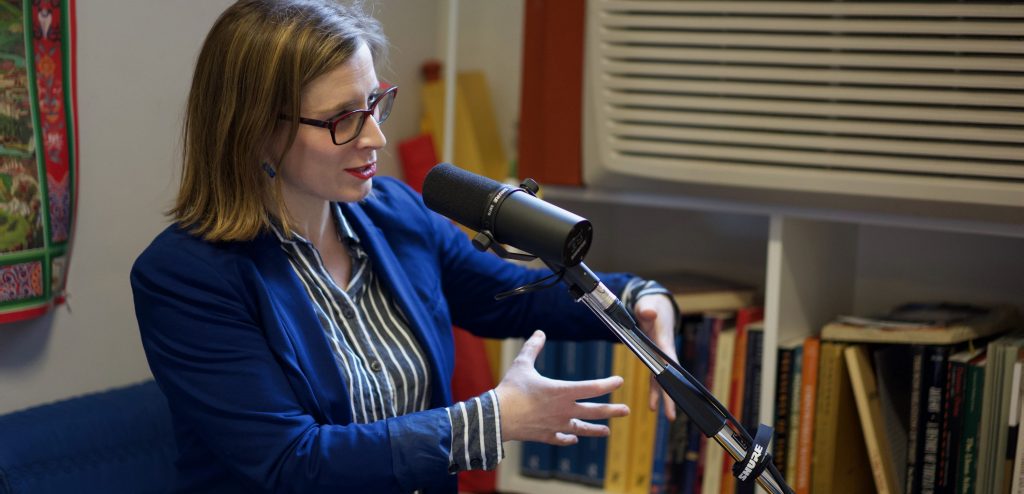Congratulations to two of our graduate students for their contributions to an edited volume published this month, Hidden Lands in Himalayan Myth and History: Transformations of sbas yul through Time, in Brill’s Tibetan Studies Library. Annie Heckman‘s chapter is on “Early Echoes of sbas yul Padma bkod in the Lifestory of Thang stong rgyal po,” and Barbara Hazelton contributed a chapter on “Padma bkod through the Lens of Two Pilgrimage Guidebooks: Walking the Body of Rdo rje phag mo” as well as two translations, “’Ja’ tshon snying po’s Guidebook to the Hidden Land of Padma bkod” and “Bdud ’joms gling pa’s Hidden Sacred Land of Padma bkod.” There’s also an article by Frances Garrett, called “Healing Mountains and Hidden Lands.” This book had its origins in the Himalayan Borderlands research project, which organized a conference several years ago, co-sponsored by the Ho Centre and Bukkyo Dendo Kyokai Yehan Numata Program in Buddhist Studies at the University of Toronto.
Sarah Richardson Wins 2020 Teaching Award

Congratulations to Dr. Sarah Richardson for winning the UTM Teaching Excellence Award for 2020! Dr. Richardson was recognized as an innovative teacher for her work on scaffolded learning, experiential learning, and trauma-informed pedagogy. Both students and colleagues commended Dr. Richardson’s efforts to make classes that are built around forming community (often getting students to work together); to cultivate opportunities for students to learn actively through doing things (she regularly takes students to museums and temples); and making sure that everyone is also having fun (she has organized art-making workshops and even an Odissi dance workshop).
Dr. Richardson also works to develop discipline-specific conversations around teaching through her work with the Ho Centre for Buddhist Studies at the University of Toronto, where she is the host for a new teaching related podcast, called The Circled Square. For this podcast she interviews colleagues from other Universities, Colleges and disciplines, about their Buddhism related teaching (see http://teachingbuddhism.net/).
Khenpo Kunga Sherab Selected as Senior Doctoral Fellow
Khenpo Kunga Sherab was selected as the Senior Doctoral Fellow at the University of Toronto’s Buddhism, Psychology and Mental Health program at New College. Since 2009 he has served as academic advisor for a number of professors and graduate students in Canada and the United States. His doctoral research focuses on the long cultural history of practices invented by Tibetans between the 13-20th centuries to identify incarnate enlightened minds among children as the basis of the trülku (sprul sku) institution. You may have seen him on the UToronto Classical Tibetan YouTube channel. Congratulations, Khenpo!
We’re Teaching Online
For our Online Teaching Resource Fellowship project, which ran throughout the strange summer of 2020, a team of University of Toronto graduate students in Buddhist Studies gathered and annotated a robust set of online resources relevant to teaching in our field.
The beta release of their work can be found on a Google sheet, for now, but this resource is currently being transformed into another format with support of the University of Toronto Libraries – please stay tuned for that.
Other resources now available can be found at the Ho Centre’s YouTube channel, pictured above, which includes a playlist of lectures from our February 2020 conference on Teaching Buddhist Studies, among other resources.
Those of you teaching or studying Tibetan may also want to keep an eye on our developing resources for teaching Classical Tibetan online, pictured below, some of which is at our Classical Tibetan YouTube channel.
And be sure to check out our podcast, The Circled Square, found at http://teachingbuddhism.net/ as well as on iTunes and the usual podcast services.
Connecting in Uncertain Times

John Vervaeke teaches wildly popular courses in Buddhism, Psychology & Mental Health undergraduate program and in the Cognitive Science program. He also teaches courses in the Psychology department on thinking and reasoning, with an emphasis on higher cognitive processes that promote intelligence, rationality, mindfulness, and wisdom. He is also founder of the Consciousness & Wisdom Studies Lab, and he has a popular YouTube channel.
Nowadays, he is also leading a daily meditation session, in an effort to help us all stay connected in these days of distraction. You can join these sessions each morning in his series of videos in response to the pandemic.
Arts & Science spoke to Vervaeke recently about his work on mindfulness and meditation in times of stress and anxiety – read the full article here.

